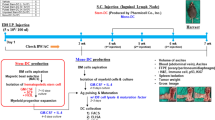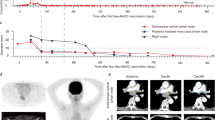Abstract
Both dendritic cell (DC)-based immunotherapy and interferon (IFN)-α therapy have been proved to have potent long-lasting antitumor effects. In anticipation of synergistic antitumor effects, we performed combination therapy with DCs and IFN-α gene-transduced murine colorectal cancer MC38 cells (MC38-IFN-α). DCs incubated with MC38-IFN-α, but not neomycin-resistance gene-transduced MC38 cells (MC38-Neo), effectively enhanced proliferation of allogeneic splenocytes in vitro. In 12 of 17 mice, DCs in combination with MC38-IFN-α prevented the development of a parental tumor, while DCs and MC38-Neo did in only three of 17 mice (P=0.008). In a therapeutic model of an established parental tumor, inoculation of DCs and MC38-IFN-α suppressed the growth of the established parental tumors significantly compared with the administration of DCs with MC38-Neo or naive splenocytes with MC38-IFN-α (P=0.016 and 0.024, respectively). Analyses of immunohistochemistry and tumor-infiltrating mononuclear cells showed that CD8+, CD11c+, and NK1.1+ cells markedly infiltrated the established tumors of mice treated with DCs and MC38-IFN-α. From the results of observation of parental tumor outgrowth in immune cell-depleted mice, CD8+ cells, and asialo-GM-1+ cells were thought to contribute to the antitumor effects induced by the combination therapy. Furthermore, MC38-specific cytolysis was detected when splenocytes of mice inoculated with DCs and MC38-IFN-α cells were stimulated with MC38-IFN-α cells in vitro. Since DC-based immunotherapy in combination with IFN-α-expressing tumor cells induces potent antitumor cellular immune responses, it should be considered for clinical application.
This is a preview of subscription content, access via your institution
Access options
Subscribe to this journal
Receive 12 print issues and online access
$259.00 per year
only $21.58 per issue
Buy this article
- Purchase on Springer Link
- Instant access to full article PDF
Prices may be subject to local taxes which are calculated during checkout





Similar content being viewed by others
Abbreviations
- DC:
-
dendritic cell
- IFN:
-
interferon
- MC38-IFN-α:
-
IFN-α-overexpressing MC38
- MC38-Neo:
-
neomycin-resistance gene-transduced MC38
- MC38-WT:
-
MC38 wild type
- MHC:
-
major histocompatibility complex
- CTL:
-
cytotoxic T-lymphocytes
- IL:
-
interleukin
- B6:
-
C57BL/6
- CM:
-
complete medium
- ELISA:
-
enzyme-linked immunosorbent assay
- TUNEL:
-
terminal deoxynucleotidyl transferase-mediated dUTP-biotin nick-end labeling assay
- ATCC:
-
American Type Culture Collection
- HBSS:
-
Hank's balanced salt solution
- FITC:
-
fluorescein isothiocyanate
- OCT:
-
optimal clotting temperature
- E:T:
-
effector to target ratio.
References
O’Connell J, Bennett MW, O’Sullivan GC, Collins JK, Shanahan F . The Fas counterattack: cancer as a site of immune privilege. Immunol Today 1999; 20: 46–52.
Steinman RM . The dendritic cell system and its role in immunogenicity. Annu Rev Immunol 1991; 9: 271–296.
Hart DN . Dendritic cells: unique leukocyte populations which control the primary immune response. Blood 1997; 90: 3245–3287.
Banchereau J, Steinman RM . Dendritic cells and the control of immunity. Nature 1998; 392: 245–252.
Albert ML, Sauter B, Bhardwaj N . Dendritic cells acquire antigen from apoptotic cells and induce class I-restricted CTLs. Nature 1998; 392: 86–89.
Sauter B, Albert ML, Francisco L, Larsson M, Somersan S, Bhardwaj N . Consequences of cell death: exposure to necrotic tumor cells, but not primary tissue cells or apoptotic cells, induces the maturation of immunostimulatory dendritic cells. J Exp Med 2000; 191: 423–434.
Rovere P, Vallinoto C, Bondanza A, Crosti MC, Rescigno M, Ricciardi-Castagnoli P et al. Bystander apoptosis triggers dendritic cell maturation and antigen-presenting function. J Immunol 1998; 161: 4467–4471.
Strome SE, Voss S, Wilcox R, Wakefield TL, Tamada K, Flies D et al. Strategies for antigen loading of dendritic cells to enhance the antitumor immune response. Cancer Res 2002; 62: 1884–1889.
Fields RC, Shimizu K, Mule JJ . Murine dendritic cells pulsed with whole tumor lysates mediate potent antitumor immune responses in vitro and in vivo. Proc Natl Acad Sci USA 1998; 95: 9482–9487.
Shimizu K, Fields RC, Giedlin M, Mule JJ . Systemic administration of interleukin 2 enhances the therapeutic efficacy of dendritic cell-based tumor vaccines. Proc Natl Acad Sci USA 1999; 96: 2268–2273.
Kotera Y, Shimizu K, Mule JJ . Comparative analysis of necrotic and apoptotic tumor cells as a source of antigen(s) in dendritic cell-based immunization. Cancer Res 2001; 61: 8105–8109.
Smith SG, Patel PM, Porte J, Selby PJ, Jackson AM . Human dendritic cells genetically engineered to express a melanoma polyepitope DNA vaccine induce multiple cytotoxic T-cell responses. Clin Cancer Res 2001; 7: 4253–4261.
Boczkowski D, Nair SK, Snyder D, Gilboa E . Dendritic cells pulsed with RNA are potent antigen-presenting cells in vitro and in vivo. J Exp Med 1996; 184: 465–472.
Li J, Holmes LM, Franek KJ, Burgin KE, Wagner TE, Wei Y . Purified hybrid cells from dendritic cell and tumor cell fusions are superior activators of antitumor immunity. Cancer Immunol Immunother 2001; 50: 456–462.
Ardavin C, Amigorena S, Reis e Sousa C . Dendritic cells: immunobiology and cancer immunotherapy. Immunity 2004; 20: 17–23.
Okada H, Lieberman FS, Edington HD, Witham TF, Wargo MJ, Cai Q et al. Autologous glioma cell vaccine admixed with interleukin-4 gene transfected fibroblasts in the treatment of recurrent glioblastoma: preliminary observations in a patient with a favorable response to therapy. J Neuro-Oncol 2003; 64: 13–20.
Juang Y, Lowther W, Kellum M, Au WC, Lin R, Hiscott J et al. Primary activation of interferon A and interferon B gene transcription by interferon regulatory factor 3. Proc Natl Acad Sci USA 1998; 95: 9837–9842.
Marie I, Durbin JE, Levy DE . Differential viral induction of distinct interferon-alpha genes by positive feedback through interferon regulatory factor-7. EMBO J 1998; 17: 6660–6669.
Okada H, Villa L, Attanucci J, Erff M, Fellows WK, Lotze MT et al. Cytokine gene therapy of gliomas: effective induction of therapeutic immunity to intracranial tumors by peripheral immunization with interleukin-4 transduced glioma cells. Gene Therapy 2001; 8: 1157–1166.
Belardelli F . Role of interferons and other cytokines in the regulation of the immune response. APMIS 1995; 103: 161–179.
Ito T, Amakawa R, Inaba M, Ikehara S, Inaba K, Fukuhara S . Differential regulation of human blood dendritic cell subsets by IFNs. J Immunol 2001; 166: 2961–2969.
von Hoegen P, Zawatzky R, Schirrmacher V . Modification of tumor cells by a low dose of Newcastle disease virus. III. Potentiation of tumor-specific cytolytic T cell activity via induction of interferon-alpha/beta. Cell Immunol 1990; 126: 80–90.
Hiroishi K, Tuting T, Tahara H, Lotze MT . Interferon-alpha gene therapy in combination with CD80 transduction reduces tumorigenicity and growth of established tumor in poorly immunogenic tumor models. Gene Therapy 1999; 6: 1988–1994.
Hiroishi K, Tuting T, Lotze MT . IFN-alpha-expressing tumor cells enhance generation and promote survival of tumor-specific CTLs. J Immunol 2000; 164: 567–572.
Santini SM, Lapenta C, Logozzi M, Parlato S, Spada M, Di Pucchio T et al. Type 1 interferon as a powerful adjuvant for monocyte-derived dendritic cell development and activity in vitro and in Hu-PBL-SCID mice. J Exp Med 2000; 191: 1777–1788.
Luft T, Pang KC, Thomas E, Hertzog P, Hart DN, Trapani J et al. Type I IFNs enhance the terminal differentiation of dendritic cells. J Immunol 1998; 161: 1947–1953.
Mohty M, Vialle-Castellano A, Nunes JA, Isnardon D, Olive D, Gaugler B . IFN-alpha skews monocyte differentiation into Toll-like receptor 7-expressing dendritic cells with potent functional activities. J Immunol 2003; 171: 3385–3393.
Dauer M, Pohl K, Obermaier B, Meskendahl T, Robe J, Schnurr M et al. Interferon-alpha disables dendritic cell precursors: dendritic cells derived from interferon-alpha-treated monocytes are defective in maturation and T-cell stimulation. Immunology 2003; 110: 38–47.
Eguchi J, Hiroishi K, Ishii S, Mitamura K . Interferon-alpha and interleukin-12 gene therapy of cancer; interferon-alpha induces tumor-specific immune responses while interleukin-12 stimulates non-specific killing. Cancer Immunol Immunother 2003; 52: 378–386.
Tsugawa T, Kuwashima N, Sato H, Fellows-Mayle WK, Dusak JE, Okada K et al. Sequential delivery of interferon-alpha gene and DCs to intracranial gliomas promotes an effective antitumor response. Gene Therapy 2004; 11: 1551–1558.
Okada H, Tsugawa T, Sato H, Kuwashima N, Gambotto A, Okada K et al. Delivery of interferon-alpha transfected dendritic cells into central nervous system tumors enhances the antitumor efficacy of peripheral peptide-based vaccines. Cancer Res 2004; 64: 5830–5838.
Nishioka Y, Hirao M, Robbins PD, Lotze MT, Tahara H . Induction of systemic and therapeutic antitumor immunity using intratumoral injection of dendritic cells genetically modified to express interleukin 12. Cancer Res 1999; 59: 4035–4041.
Hirao M, Onai N, Hiroishi K, Watkins SC, Matsushima K, Robbins PD et al. CC chemokine receptor-7 on dendritic cells is induced after interaction with apoptotic tumor cells: critical role in migration from the tumor site to draining lymph nodes. Cancer Res 2000; 60: 2209–2217.
Pear WS, Nolan GP, Scott ML, Baltimore D . Production of high-titer helper-free retroviruses by transient transfection. Proc Natl Acad Sci USA 1993; 90: 8392–8396.
Shimamura H, Cumberland R, Hiroishi K, Watkins SC, Lotze MT, Baar J . Murine dendritic cell-induced tumor apoptosis is partially mediated by nitric oxide. J Immunother 2002; 25: 226–234.
Acknowledgements
This study was supported in part by a grant from Grant-in-Aid for Scientific Research (C) from The Ministry of Education, Culture, Sports, Science, and Technology of Japan.
Author information
Authors and Affiliations
Corresponding author
Rights and permissions
About this article
Cite this article
Ishii, S., Hiroishi, K., Eguchi, J. et al. Dendritic cell therapy with interferon-α synergistically suppresses outgrowth of established tumors in a murine colorectal cancer model. Gene Ther 13, 78–87 (2006). https://doi.org/10.1038/sj.gt.3302608
Received:
Revised:
Accepted:
Published:
Issue Date:
DOI: https://doi.org/10.1038/sj.gt.3302608
Keywords
This article is cited by
-
Effects of interferon-α-transduced tumor cell vaccines and blockade of programmed cell death-1 on the growth of established tumors
Cancer Gene Therapy (2012)
-
Recombinant Vesicular Stomatitis Virus Transduction of Dendritic Cells Enhances Their Ability to Prime Innate and Adaptive Antitumor Immunity
Molecular Therapy (2009)
-
A Kunjin replicon vector encoding granulocyte macrophage colony-stimulating factor for intra-tumoral gene therapy
Gene Therapy (2009)



